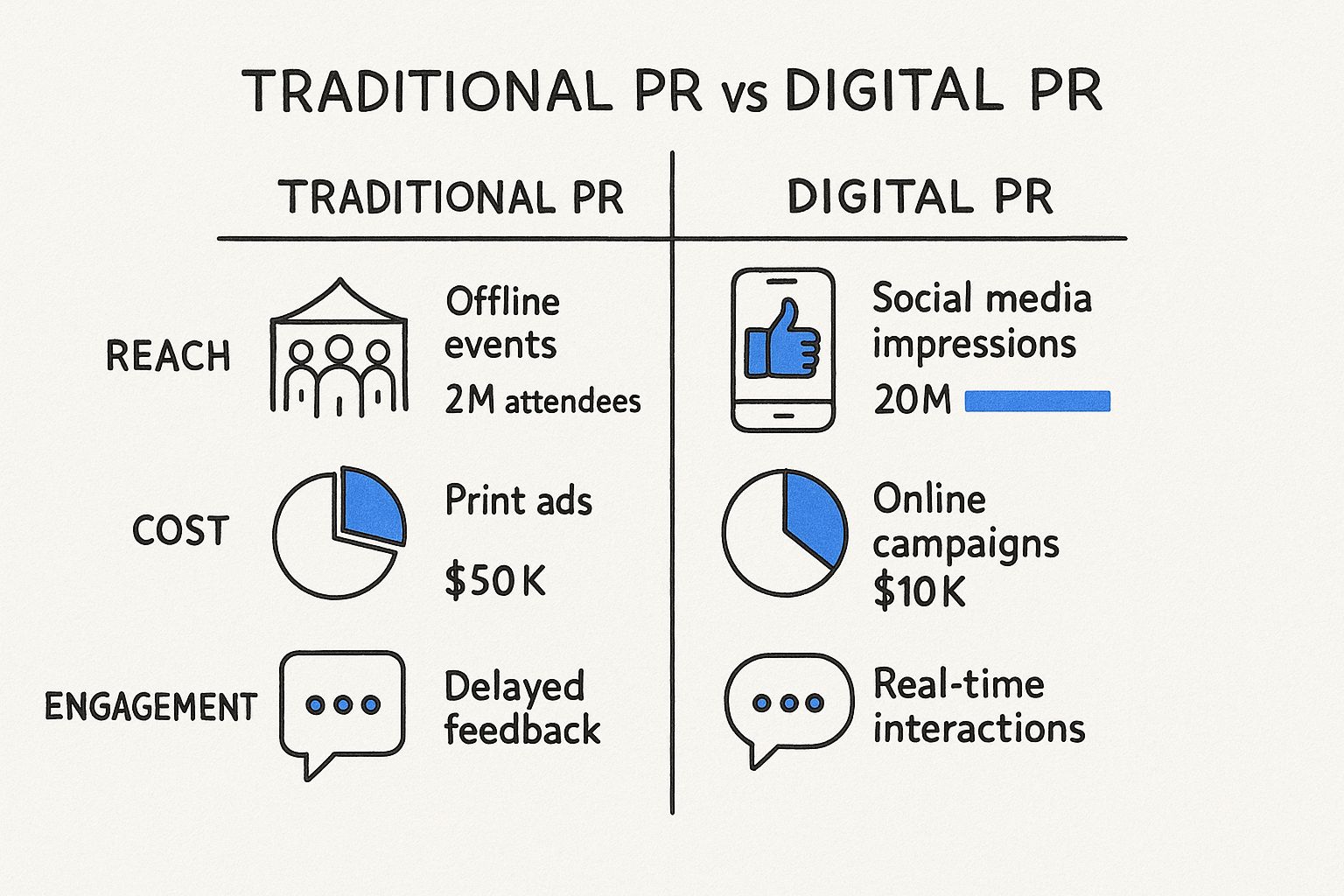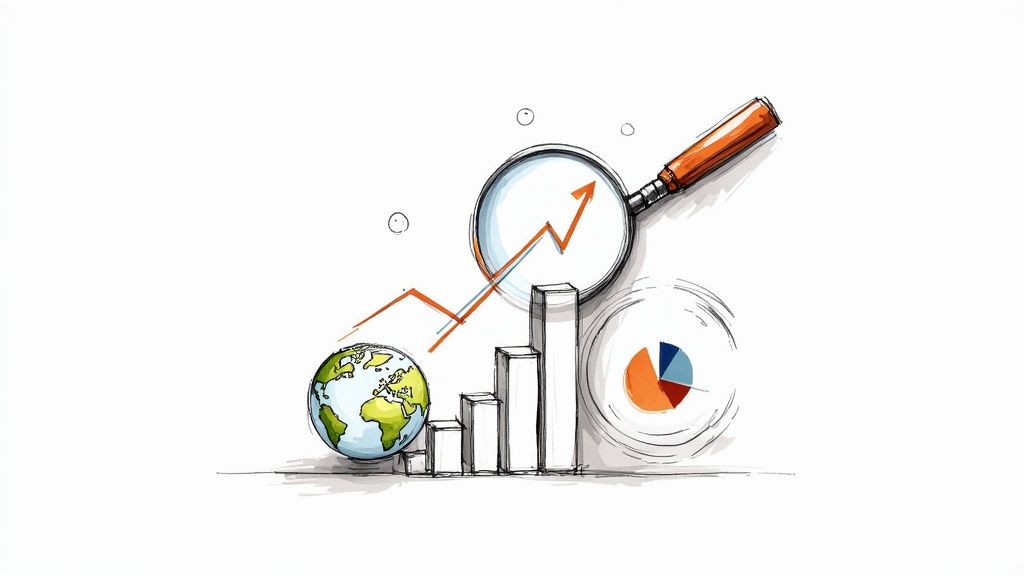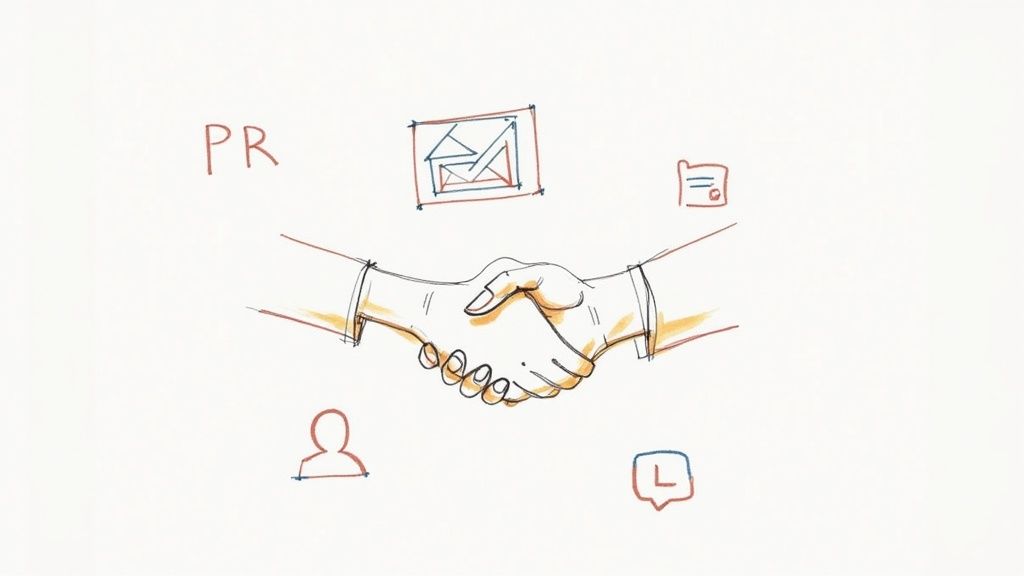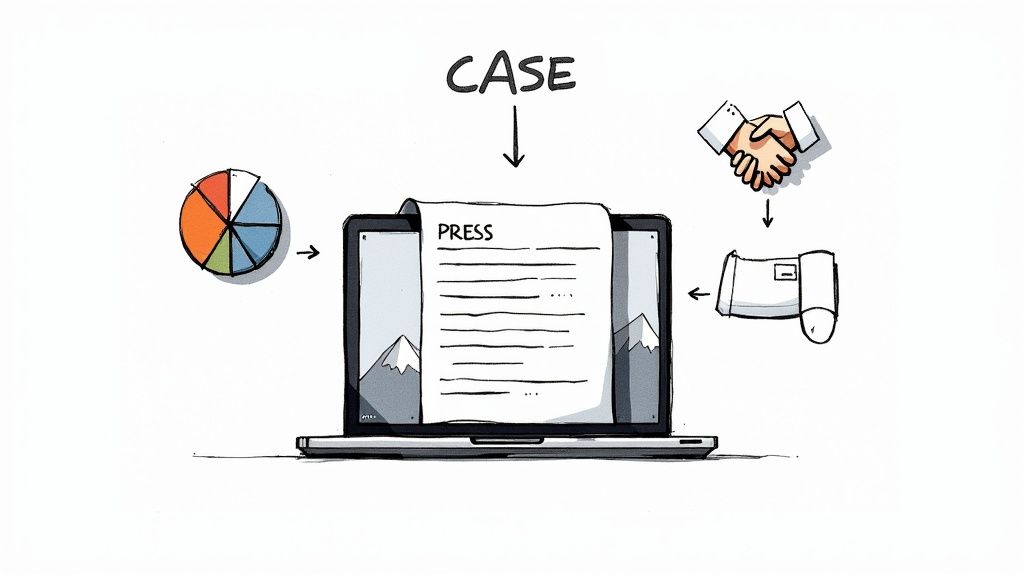What Is Digital PR and How Does It Work?
October 8, 2025

Remember traditional public relations? It was all about landing a feature on one of the big TV networks or getting your brand into a glossy magazine. Digital PR takes that same core idea—earning credibility—and applies it to the entire online world. It’s the modern-day strategy for getting your brand mentioned and linked on news sites, popular blogs, and social media platforms where your audience actually hangs out.
What Is Digital PR in Simple Terms
At its heart, digital PR is an online marketing tactic designed to massively expand a company's digital presence. It’s a smart blend of old-school relationship-building, like in traditional PR, with the measurable, data-heavy tactics of SEO and content marketing. The main objective? To earn high-quality backlinks, get people talking about you on social media, and rack up positive online press.
Success in the old days was measured by things like "column inches" in a newspaper. Digital PR, on the other hand, is all about tangible online results. Every single mention, link, and share builds up your brand's online authority, which directly influences how easily new customers can find you on Google.
The Evolution from Print to Pixels
The whole game changed when people stopped waiting for the morning paper and started searching for everything online. We look up reviews, follow industry experts on social media, and get our news from a dozen different websites. This shift in how we consume information meant PR had to evolve, too.
Digital PR rises to this challenge by concentrating on a few key areas:
- Online Media Coverage: Getting your brand featured, quoted, or mentioned in the online publications, blogs, and podcasts that your ideal customers read and trust.
- High-Quality Backlinks: Earning links from authoritative websites back to your own. Think of these as powerful "votes of confidence" that tell search engines your site is a credible resource, giving your SEO a major boost.
- Building Brand Authority: Positioning your company and its key people as the go-to experts in your niche through expert commentary and guest articles.
To really see the difference, let's put the two side-by-side.
Traditional PR vs. Digital PR At a Glance
The table below offers a quick snapshot of how these two approaches stack up in key areas, from the channels they use to how they measure success.
| Aspect | Traditional PR | Digital PR |
|---|---|---|
| Channels | Print (newspapers, magazines), TV, Radio | Online news sites, blogs, podcasts, social media, forums |
| Key Metric | Ad Value Equivalency (AVE), column inches, reach | Backlinks, referral traffic, search rankings, social shares |
| Audience | Broad, general audience | Highly specific, targeted demographics and interests |
| Speed | Slow, long lead times (weeks or months) | Fast, real-time engagement and feedback |
| Longevity | Short-lived (one-day story) | Permanent, content lives online indefinitely |
| Cost | Often very high (retainers, print fees) | More cost-effective, higher ROI potential |
As you can see, the move to digital isn't just about changing channels; it's a fundamental shift towards a more targeted, measurable, and long-lasting strategy for building a brand's reputation.
This infographic helps visualize the core differences in reach, cost, and overall engagement.

The numbers make it clear: digital PR provides a much wider reach and instant feedback, often for a fraction of the cost. This modern approach is essential for any brand that wants to connect visibility with real, trackable business performance. To get an even better grasp on this, you can learn more about the fundamentals of what is media relations in our detailed guide.
Why Digital PR Is No Longer Optional

In the not-so-distant past, brands fought for attention with big ad budgets and glossy magazine spreads. Today, that battlefield has moved online, and the rules of engagement have completely changed. It’s no longer about who can shout the loudest; it's about who earns the most credible conversations online.
The world has shifted. Traditional media is fading, and search engines have taken their place as the ultimate gatekeeper of information. When someone needs a solution, their first instinct isn’t to pick up a phone book—it’s to type a question into Google.
This change alone makes digital PR a core business function. Your brand's reputation is now defined by what shows up on a search results page, the reviews people leave, and the online publications that mention your name. If you’re not actively managing that, you’re basically invisible to your ideal customer.
The New Currency of Brand Trust
Think of every quality backlink, positive mention, and expert quote as a vote of confidence. Each one tells both potential customers and search engines that you're the real deal—a trustworthy authority in your field. This is earned trust. You can't buy it, and it's infinitely more valuable than a flashy banner ad.
This gets to the heart of what is digital PR. It's the engine that methodically builds this online credibility. Without a strategy, you’re just hoping for the best, letting your competitors write the story and steal the top spots for keywords that should be yours.
The numbers don't lie. The global public relations market is on track to hit $113 billion by 2025, a massive leap from $63 billion in 2018. Why the surge? Businesses are scrambling to build online authority. In fact, over 60% of online businesses now outsource their digital PR to experts who know how to navigate this world. You can dive deeper into these trends on the evolving PR landscape at prlab.co.
Why a Passive Online Presence Fails
Just having a website and a few social media accounts is like owning a storefront on a deserted street. It's not enough. A passive approach means you’re letting others—customers, critics, and competitors—define your brand narrative. A single bad review or a rival's smart campaign can quickly drown you out.
Proactive digital PR is about grabbing the microphone. It turns your business from a quiet observer into an active, influential voice in your industry.
A strong digital PR strategy ensures that when customers search for solutions, your brand appears as a credible, authoritative, and trusted answer. It’s the difference between being discovered and being ignored.
At the end of the day, digital PR is simply the modern way to build a reputation. It's a direct response to how people actually find and vet businesses today—by focusing on the signals that build genuine authority where it matters most: online.
Core Strategies That Drive Digital PR Success

It’s one thing to understand what digital PR is, but it’s another thing entirely to actually do it well. Getting great results isn't about blind luck; it comes from using a few proven strategies that consistently build authority and earn those all-important backlinks. These are the tactics that take your brand from just another company shouting into the void to a trusted source that journalists and readers actually want to hear from.
At the heart of it all is one simple idea: create something genuinely newsworthy. This could be an original data study, a really compelling infographic, or an expert take that cuts through the noise on a trending topic.
Creating Linkable Assets That Journalists Love
By far, the most powerful way to get high-quality backlinks is to create content so good that other sites can't help but link to it. In the industry, we call these linkable assets. The magic here is that you stop begging for links and start offering a resource that makes a journalist's article stronger.
These assets are the bedrock of any solid digital PR campaign because they’re built on originality and genuine value. Think of them as magnets for media attention.
So, what does a great linkable asset look like?
- Original Data and Research: This is the gold standard. Survey your audience or dig into your own data to find a surprising trend. Journalists absolutely love exclusive stats they can't get anywhere else.
- Comprehensive Guides and How-Tos: Become the go-to source on a topic in your niche. If you create the most thorough, helpful guide on the internet, others will naturally reference it.
- Visual Content: A well-designed infographic or an interactive map can make complex information incredibly easy to understand and share. They're practically built to be embedded in other articles.
- Free Tools and Calculators: If you can build a simple tool that solves a real problem for your audience, you've created a natural link magnet. People will share it because it's genuinely useful.
When you create these kinds of resources, you completely flip the script from asking for a favor to providing real value.
Building Authentic Media Relationships
Assets are your hook, but the human element is what lands the fish. Taking the time to build real, authentic relationships with journalists, editors, and bloggers in your space is a long game that pays off massively. Forget spamming a list of 500 contacts with a generic press release—that just doesn't work anymore.
The right way to do it is with thoughtful, personalized outreach. Read what a journalist writes. Understand their beat. Then, approach them with a story idea or a data point that actually fits what they cover.
A personalized pitch that shows you’ve done your homework will always outperform a mass email blast. It demonstrates respect for the journalist's time and expertise, laying the groundwork for a mutually beneficial relationship.
Over time, when you become known as a reliable source for interesting information, journalists will start coming to you for quotes and insights. That’s when you know you’re doing it right.
Leveraging Guest Blogging for Authority
Another workhorse strategy is guest blogging. This is where you write and publish articles on other well-respected websites in your industry. I'm not talking about stuffing keywords into a cheap article for a quick backlink; that's old-school and ineffective.
Modern guest blogging is about lending your expertise to a reputable platform. Done correctly, it helps you:
- Reach a New, Relevant Audience: You get to tap into the readership that another site has already built.
- Build Credibility: Your brand becomes associated with other trusted names in your field.
- Earn a High-Quality Backlink: You get a powerful, editorially-vetted link pointing back to your site.
The secret is focusing on quality over quantity. Target a handful of respected publications where your insights will truly shine, and you'll build authority while driving meaningful traffic back to your own site.
How Digital PR Directly Fuels Your SEO
Digital PR isn't just about getting your name in the headlines—it's one of the most powerful and lasting ways to climb the search engine rankings. The connection between the two is direct and incredibly impactful.
When a credible, high-authority website mentions and links back to your site, it sends a powerful signal to search engines like Google. Think of each of these high-quality backlinks as a vote of confidence. The algorithm interprets these votes as proof that your content is trustworthy, valuable, and worth showing to more people.
In fact, a single backlink from a major news outlet or respected industry blog can be more powerful than hundreds of low-quality links. That's what makes digital PR such an efficient and potent SEO strategy.
Building Your Backlink Foundation
A well-executed digital PR campaign is all about building a natural and diverse backlink profile. It's the polar opposite of old-school, spammy link-building tactics. Instead, it focuses on earning links editorially.
This means journalists and editors choose to link to your site because your content, data, or expert insights genuinely add value to their stories. This organic approach is exactly what search engines are designed to reward.
Over time, this process builds a rock-solid foundation of authority that is incredibly difficult for your competitors to copy. It's not a numbers game; it's about the quality and relevance of each link you earn.
The connection between digital PR and SEO has become so undeniable that 51% of PR teams now work hand-in-hand with SEO specialists. This partnership ensures campaigns create more than just media buzz—they generate the high-authority backlinks crucial for boosting search rankings. You can explore more key insights into modern PR strategies.
Beyond Backlinks: Brand Mentions and Authority
But what about media placements that don't include a direct link? They still play a vital role in your SEO. These unlinked brand mentions are important signals that help search engines recognize your company as a legitimate and relevant entity in your industry.
These mentions build up your overall topical authority. When Google consistently sees your brand name associated with specific keywords and topics across the web, it reinforces your expertise. This, in turn, helps you rank higher for those terms, establishing your site as a go-to resource.
Each piece of coverage contributes to the bigger picture of your brand's online reputation, showcasing the true value of earned media beyond just a single click. Ultimately, investing in a smart digital PR strategy is one of the best long-term moves you can make for your organic visibility.
Expanding Your Reach with Social Media and Influencers

Getting your story into a top-tier publication is a massive win, but that’s really just the beginning. The smartest digital PR campaigns don't stop there. They take that hard-earned press and amplify it, using social media and industry influencers to turn a single mention into a massive conversation.
Think about it this way: a news article is like a powerful broadcast from one station. Adding social media and influencers is like giving that broadcast to a hundred different DJs, each with their own loyal audience, who then remix and share it in their own unique way. You're not just hoping people stumble across your story; you're actively taking it to them on the platforms they use every day.
The Power of Influencer Partnerships
When we talk about influencers in digital PR, we're not talking about paying a celebrity for a generic sponsored post. This is about building real partnerships with credible voices who have built genuine trust within a specific community. It's their stamp of approval that gives your brand a powerful third-party validation that you just can't buy with traditional ads.
When an influencer shares your story, it feels less like a sales pitch and more like a recommendation from a friend. That’s the key to cutting through the skepticism and building real brand affinity.
So, what does this look like in practice?
- Micro-Influencers: These are experts with smaller but incredibly dedicated followings in a niche. Their word often carries more weight because their audience trusts their expertise implicitly.
- Co-created Content: This involves working directly with an influencer to create something unique—maybe a video, an in-depth article, or a social series—that shows your brand's value in an authentic way.
- Product Seeding: It can be as simple as sending your product to relevant influencers to try. The goal is an honest review or feature, shared with their followers.
This isn't just a fringe tactic anymore; it's central to how modern brands are built. By 2025, it’s expected that 93% of marketers will have influencers baked into their campaigns, and 91% of businesses already rely on social media to get their message out. You can dig into more of these key digital PR statistics on bluetree.digital.
Using Social Media to Shape the Narrative
Social media isn't just a place to blast out links. It’s your real-time command center for reputation management. It’s where you can share your media wins, talk directly with customers and critics, and jump into conversations happening in your industry.
When a story about your brand breaks—good or bad—where does the conversation go? Straight to social media. A smart digital PR strategy means you’re already there, ready to share your perspective, clear up any confusion, and engage with feedback. It gives you a direct hand in shaping how your brand is perceived.
By weaving social media and influencer marketing together, you create a powerful echo chamber for your message. A single news story gets shared by your brand, picked up by influencers, and then discussed by their communities. This creates layers of social proof that build trust and drive real business results. This is the essence of understanding what is digital PR in today's world.
Measuring What Really Matters in Digital PR
So you’ve launched a digital PR campaign and the press hits are rolling in. That’s great, but how do you actually know if it's working? It’s tempting to just count the number of articles, but real success goes way beyond vanity metrics. The goal is to prove that your efforts are making a tangible difference to the business.
We need to connect the dots between a media placement and a business outcome. Did that article actually send people to your website? Is it making you more visible on Google? Are you reaching the people who might actually buy from you? Answering these questions is how you demonstrate the true value of your work.
The KPIs That Tell the Full Story
To get a clear picture of your campaign's performance, you need to track the right things. A solid measurement framework moves beyond simple "buzz" and focuses on the metrics that show a real return on your investment.
Here are the big ones to keep an eye on:
- Backlinks (Quality Over Quantity): Don't just count how many links you got. The real gold is in their authority. One powerful link from a major industry publication can do more for your SEO than 50 links from small, unknown blogs.
- Referral Traffic: This is your direct proof of engagement. Using your analytics, you can see exactly how many people clicked through from a media placement to your site. High referral traffic means the story resonated with the right audience.
- Organic Keyword Rankings: As you earn high-quality backlinks, you should start climbing the search engine rankings for your target keywords. This is a long-term play, but it's one of the most valuable outcomes of a strong digital PR strategy.
It's easy to get caught up in counting media mentions. The real win, however, is understanding how that coverage translates into meaningful website traffic, a stronger SEO footprint, and ultimately, more leads in your pipeline.
Tools of the Trade and Share of Voice
Beyond the core KPIs, it's also smart to look at your Share of Voice (SOV). This metric is all about context—it shows you how your brand’s visibility stacks up against your direct competitors. Are you just making noise, or are you actually owning the conversation in your industry?
Of course, tracking all of this requires the right toolkit. You can't fly blind. Tools like Google Analytics, Ahrefs, and Semrush are non-negotiable for monitoring traffic, analyzing backlinks, and tracking your keyword progress. For a much deeper look at this, we have a complete guide on public relations measurement that breaks it all down.
By focusing on these metrics, you can confidently show anyone—from your boss to your investors—the concrete impact of your digital PR efforts.
Got Questions About Digital PR? Let's Get Them Answered
Even when the concept makes sense, a few questions always pop up when businesses first dip their toes into digital PR. Let's tackle some of the most common ones to paint a clearer picture.
What's the Real Difference Between Digital PR and Content Marketing?
It’s easy to get these two mixed up because they often work together, but their core jobs are totally different. Think of it this way: content marketing is all about building your own stage—your blog, your social media, your newsletter. You create great stuff to pull an audience to your property.
Digital PR, on the other hand, is about getting a spotlight on someone else’s bigger, more established stage. You're aiming to get your brand, your data, or your expert opinion featured on respected news sites, industry blogs, and other media outlets.
Content marketing builds your home base. Digital PR gets you invited to all the best parties, building credibility and powerful backlinks from other people's platforms.
How Long Until I Actually See Results?
Let's be real: digital PR is a long game, not an overnight fix. It’s more like planting a tree than flipping a switch. You might land your first media mention or backlink within a few months, which is a great start.
But to see the kind of results that really move the needle on your SEO and brand authority, you should plan for a sustained effort of at least 6 to 12 months. The magic is in the momentum—each placement builds on the last, creating a powerful compounding effect over time.
Can a Small Business Really Pull This Off?
Yes, one hundred percent. In fact, digital PR is one of the best ways for smaller businesses to punch way above their weight class. You don't need a Super Bowl-sized ad budget to compete; you just need a great story, a unique piece of data, or a fresh expert take.
This is how nimble startups and small businesses earn coverage in major publications, securing the kind of high-authority backlinks that can truly level the playing field against bigger, more established competitors.
Ready to stop hoping for media coverage and start earning it? PressBeat automates your press outreach with AI-powered precision, connecting your story with the right journalists every time. Discover how PressBeat can amplify your brand's voice today.